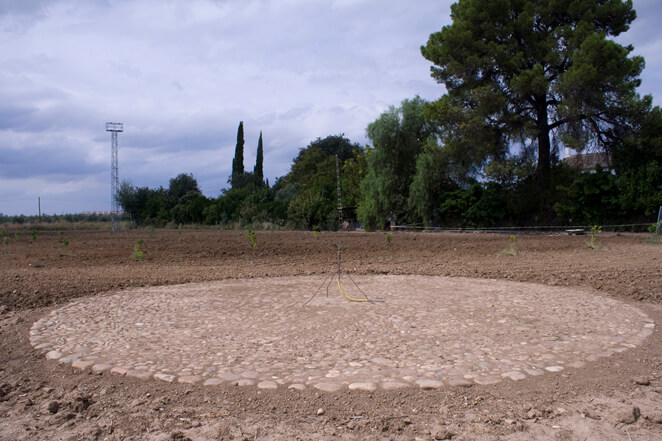Huertopoema de los días

Villarrubia, Córdoba.
This is a project of ecopoetic intervention, started in winter 2012, where artistic and everyday ways of existence converse about art and agriculture; being this triple ecological thinking (mental, social and environmental) the engine for the positioning and affirmation of rural areas. The work proposal aims at building a multi-use ecological park (where vegetable garden, hens, fruit trees and people meet), towards a coexistence of organic production and artistic production. Searching for balance in the use of space, such as field, vegetable garden and piece of art; a way of life combining agricultural and cultural activities (workshops, installations, performances, video creation, etc.)


This poem entitled "Huertopoema de los días" comes from the orientation of the field on which we have drawn the Huertopoema; looking southwards, with Sierra Morena and the cottage behind us, from left to right the arch of the day is drawn. We’ve been carried away by the sun, the air, the days. The fruit tree lines, living beings drawing spatial-temporal coordinates, the relationship between poem and life or, to be more precise, between sensitive nature and nature of sense. Signifier and signified come together to form an idea: time. It’s time indeed what Huertopoema intends to delay and spread, distinctly by the correspondent use of graphemes poetically handled in an approach to concrete poetry methods, and at a visual level by the iconic use of lines and forms.
The word Huertopoema condenses this vision of the land, cultivation space and the sheet of paper, the blank space of the contemporary multidisciplinary creation. Huertopoema is a vegetable garden, a place (topos) for the creation (poetics).


TOPOS
HUERTO (Topoems by Octavio Paz)
POEM
Spatial poetry, in opposition to temporal poetry, discursive. As a resource against discourse. The title aims at expanding the poetic programme underlying poems. A Huertopoema is thus a poem in which "the place", "the position" of vital matter acquires a semantic value. By this we refer to the complementary syntactic distribution of graphemes in a given typographic layout. This distribution, which can even have iconic purposes, turns out to be semantic and forms meaning by the act of reading and/or by the reader’s/observer’s visual perception of the poem.
Thematically, the exaltation of creation, of sowing and harvesting, of being born and dying: the opposition between movement and stillness or rectilinear time and circular time. The interest in being so (So-Sein) of the poem turned into a vegetable garden; the procedure of not only enouncing the temporal circularity, but also symbolising it; the possibilities of significance the blank sheet layout offers, same as the arable land ready for cultivation. Graphic and vital signs not only get into movement thanks to sight, touch, smell, taste and hearing but also by an instinctive whirling around each other.
Poetologically, Huertopoema is placed between A throw of the dice by Mallarmé, Blanco and Topoems by Octavio Paz, and Littel Sparta by Ian Hamilton Finlay. It draws on pictogram tradition. At the same time, it shows signs of a more explicit approach to the principles of concrete poetry. Another intertextual relationship is established between Huertopoema and ideographic writing and poetics of verbal reduction in classical Chinese poetry. The appropriation of pictogram tradition by José Juan Tablada during avant-garde movements in the second decade of twentieth century, takes us to haiku poetics and its connections with Zen buddhism.
Considering the useful, it seeks to bring together creation, work and everyday existence. In this sense, art creates unprecedented meeting points, reveals relationships gone unnoticed, generates incredible lives and new uses: to strengthen our relationship with the world and to resist the hegemony of spectacular economy.
It’s not about generating meaning with the help of represented signs, but rather producing relationships with the world in everyday life. The piece of work creates value models, proposes economies of existence, the «possibilities of life» brought up by Nietzsche. Like the term ecosophy, proposed by Felix Guattari, teaching us to «think transversally» in a world where exchange is impossible and productions are standardised. Against this standardisation we must invent territories, cultivate curiosities, produce our existence.
This project is well aware of the architectonic context given, and the fact that thanks to its way of adapting, it conceives the existing profane structure of the place as a whole, and in this way it fits the different elements of a canon (in a musical sense) in situ. Its fundamental principle is based on an elementary spatial order and rational arrangements, as well as a comparative grammar that encrypts its interpretation and its knowledge no longer in aesthetics, but through intuition.
Intuition domains the very idea of everyday life. The relationship between one and the others in a given space. The initial movement by which the relationship between one and another is perpetuated, reproduced or reinvented. The outside and the inside, there and here, the other and the self are combined through looks and peculiar experiences to negotiate with oneself and the other.
Each work reflects some physiological dispositions and small existential decisions that express a compendium of choices, habits and gestures specialised in actions or objects. These ways of doing portray a conduct in line with a general economy of existence. The form is not an end in itself, but the implementation of a process aiming at the abolition -by all possible means- of the distance between art and life.
The quest for a fair existence concerning circumstances creates and works with ways of thinking and lifestyles that give rise to a new relationship with the world. Life is work’s stage. Creating is living: lived time and creation time overlap.

More information: http://culturhaza.blogspot.com